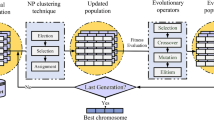Abstract
This paper proposes a genetic-algorithm-based approach for finding a compact reference set used in nearest neighbor classification. The reference set is designed by selecting a small number of reference patterns from a large number of training patterns using a genetic algorithm. The genetic algorithm also removes unnecessary features. The reference set in our nearest neighbor classification consists of selected patterns with selected features. A binary string is used for representing the inclusion (or exclusion) of each pattern and feature in the reference set. Our goal is to minimize the number of selected patterns, to minimize the number of selected features, and to maximize the classification performance of the reference set. The effectiveness of our approach is examined by computer simulations on commonly used data sets.
Preview
Unable to display preview. Download preview PDF.
Similar content being viewed by others
References
Cover, T.M., and Hart, P. E.: “Nearest neighbor pattern classification,” IEEE Trans. on Information Theory. 13 (1967) 21–27.
Hart, P.: “The condensed nearest neighbor rule,” IEEE Trans. on Information Theory. 14 (1968) 515–516.
Wilson, D. L.: “Asymptotic properties of nearest neighbor rules using edited data,” IEEE Trans. on Systems, Man, and Cybernetics. 2 (1972) 408–420.
Dasarathy, B. V.: “Minimal consistent set (MCS) identification for optimal nearest neighbor decision systems design,” IEEE Trans. on Systems, Man, and Cybernetics. 24 (1994) 511–517.
Chaudhuri, D., et al.: “Finding a subset of representative points in a data set,” IEEE Trans. on Systems, Man, and Cybernetics. 24 (1994) 1416–1424.
Kuncheva, L. I.: “Editing for the k-nearest neighbors rule by a genetic algorithm,” Pattern Recognition Letters. 16 (1995) 809–814.
Kuncheva, L. I.: “Fitness functions in editing k-NN reference set by genetic algorithms,” Pattern Recognition. 30 (1997) 1041–1049.
Siedlecki, W., and Sklansky, J.: “A note on genetic algorithms for large-scale feature selection,” Pattern Recognition Letters. 10 (1989) 335–347.
Kelly, J. D. Jr., and Davis, L.: “Hybridizing the genetic algorithm and the k nearest neighbors classification algorithm,” Proceedings of 4th International Conference on Genetic Algorithm. University California. San Diego (July 13—16, 1991) Morgan Kaufmann Publisher. San Mateo (1991) 377–383.
Punch W. F., et al.: “Further research on feature selection and classification using genetic algorithms,” Proceedings of 5th International Conference on Genetic Algorithm. University of Illinois at Urbana-Champaign (July 17—21. 1993) Morgan Kaufmann Publisher. San Mateo (1993) 557–564.
Knight, L., and Sen, S.: PLEASE: “A prototype learning system using genetic algorithm,” In: Proceedings of 6th International Conference on Genetic Algorithm. University of Pittsburgh (July 15—19. 1995). Morgan Kaufmann Publisher. San Francisco (1995) 429–435.
Ishibuchi, H., Murata, T., and Turksen, I.B.: “Single-objective and two-objective genetic algorithms for selecting linguistic rules for pattern classification problems,” Fuzzy Sets and Systems. 89 (1997) 135–149.
Nakashima, T., and Ishibuchi, H.: “GA-based approaches for finding the minimum reference set for nearest neighbor classification,” Proceedings of 5th IEEE International Conference on Evolutionary Computation. Anchorage (March 4—9. 1998). 709–714.
Author information
Authors and Affiliations
Editor information
Editors and Affiliations
Rights and permissions
Copyright information
© 1999 Springer-Verlag Berlin Heidelberg
About this paper
Cite this paper
Ishibuchi, H., Nakashima, T. (1999). Evolution of Reference Sets in Nearest Neighbor Classification. In: McKay, B., Yao, X., Newton, C.S., Kim, JH., Furuhashi, T. (eds) Simulated Evolution and Learning. SEAL 1998. Lecture Notes in Computer Science(), vol 1585. Springer, Berlin, Heidelberg. https://doi.org/10.1007/3-540-48873-1_12
Download citation
DOI: https://doi.org/10.1007/3-540-48873-1_12
Published:
Publisher Name: Springer, Berlin, Heidelberg
Print ISBN: 978-3-540-65907-5
Online ISBN: 978-3-540-48873-6
eBook Packages: Springer Book Archive




